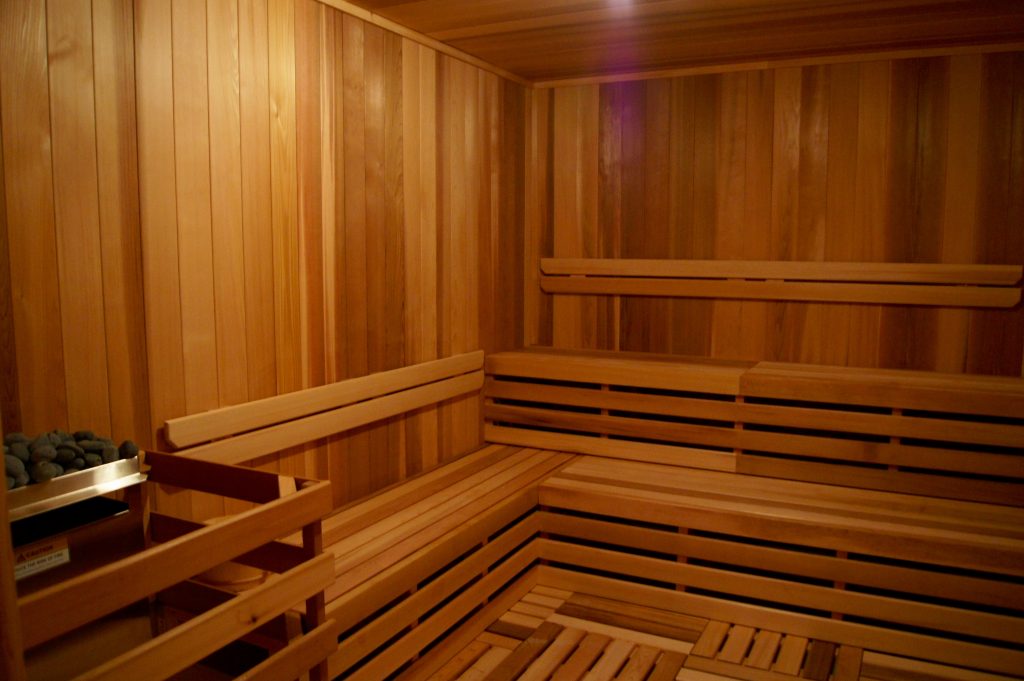By Dr. Jon Conant, LAc
In our last blog on sauna, we explained the wonderful health benefits of using it as a therapy and also noted that we offer two types of sauna at Root: infrared and traditional dry sauna. This led to questions about the differences between them, so we wanted to offer further explanation to help you choose the one that is best for you. The short answer: both are phenomenal, and you should be in one now, adding many more wonderful and healthy years to your life! But we understand you can’t access this blog from inside of one, so here’s some information to consider on your way:

The difference between infrared and traditional sauna is primarily the source of heat and how it affects your body. Traditional dry sauna utilizes a physical source to generate heat in the air in the room, usually a wood fired stove, or stones warmed by an enclosed electrical or natural gas heating element. The heat from the warmed air crosses into your skin and stimulates a physiological response as your body attempts to balance itself with the hot environment and maintain a homeostatic state. In traditional sauna, water is sometimes poured on the rocks to create humidity in the room, which comes in contact with your skin and this creates a medium to allow the heat to travel into your body faster, slowing the cooling ability of your body by stopping the evaporation of sweat, and therefore stimulating an even more vigorous physiological response.
Infrared sauna, on the other hand, utilizes a uniquely designed bulb, or heating element made from a specific ceramic or metal, that emits infrared energy. This energy is the same wavelength as sunlight generating warmth and heat, causing the soothing and deep warmth you feel when exposing your skin to sun. It’s kind of like harnessing the healthier aspects of sunbathing, but without extended exposure to the damaging aspects of sunlight such as UV rays. How safe is infrared light? It’s used in neonatal ICUs across the globe to help keep newborns at healthy and nurturing temperatures.

Another advantage to using an infrared sauna is that heat can be generated deeper into your body’s core as compared to traditional dry sauna. The nature of the longer wavelengths within the infrared spectrum is that they can travel deeper into your body, as studies show heat from infrared is directly generated over 2 inches deep, and warms you closer to your core. While research is still underway, it’s speculated that this aspect of infrared sauna is what makes it superior for detoxification, physical performance, and arthritic pain. Research of infrared sauna shows it improves physical performance across the spectrum, from athletes to individuals challenged with heart disease. It has been shown to improve cardiac function and exercise capacity in individuals with chronic heart disease, and improve blood circulation and stimulate formation of new blood vessels in subjects with diabetes or peripheral arterial disease. It’s also been found to improve mood, boost energy, and alleviate depression and anxiety in individuals with chronic fatigue syndrome. If that isn’t enough, preliminary studies show benefits of infrared sauna to decrease pain from fibromyalgia, and autoimmune conditions such as ankylosing spondylitis and rheumatoid arthritis, probably from the deep and direct effect of heat which allows improved circulation and reduction of inflammation in those joints and soft tissue. Examination surrounding another autoimmune condition, Sjogren’s Syndrome, has shown significant reduction of associated symptoms such as arthritic pain and dry mouth as well. Some studies show that infrared sauna also helps stimulate release of certain chemical compounds within the body, particularly nitric oxide, that relaxes and opens blood vessels, which in turn help prevent diseases of your blood vessels such as atherosclerosis, and reduce blood pressure. It’s not hard to extrapolate that nearly any condition caused by impairment of blood circulation or inflammation can gain relief from use of sauna.
Another advantage of infrared is that it is easier-tolerated than other types of sauna. Since the infrared light is absorbed by your body and it is warmed directly, it doesn’t require the air to be heated or as humid as traditional sauna. If you’re a person who doesn’t care for traditional sauna due to its intensity, but would enjoy the wonderful health benefits, infrared sauna is the choice for you. Another thing that people enjoy about infrared sauna is the individualized and private nature of the experience. Since treatment sessions are reserved and the sauna is private to you, heat settings can be adjusted to your tolerance and health needs. This solitude also provides an environment of tranquility as well, offering you a meditative incubator for the health of your mind and body.
There are obvious and validated reasons to utilize regular sauna to maximize your health and longevity, but it’s always important to check with a healthcare expert when starting a program. We happen to know a few wise and talented providers that would love to tailor a sauna regime that fits you and your particular needs. We’d love to have you incubating toward better health in our infrared sauna soon.
Thanks for reading.
With qi,
-Dr. Jon Conant, LAc
Acupuncturist, Oriental Medicine
Jon’s lifelong discovery of medicine and treatment has stemmed from over two decades of continued education and nearly 10 years in health care. His fascination with healing and medicine is shown in his kindness and commitment to his patients, supporting them on their path to health using the transformative wisdom of Asian medicine. Read more about Dr. Jon Conant.


